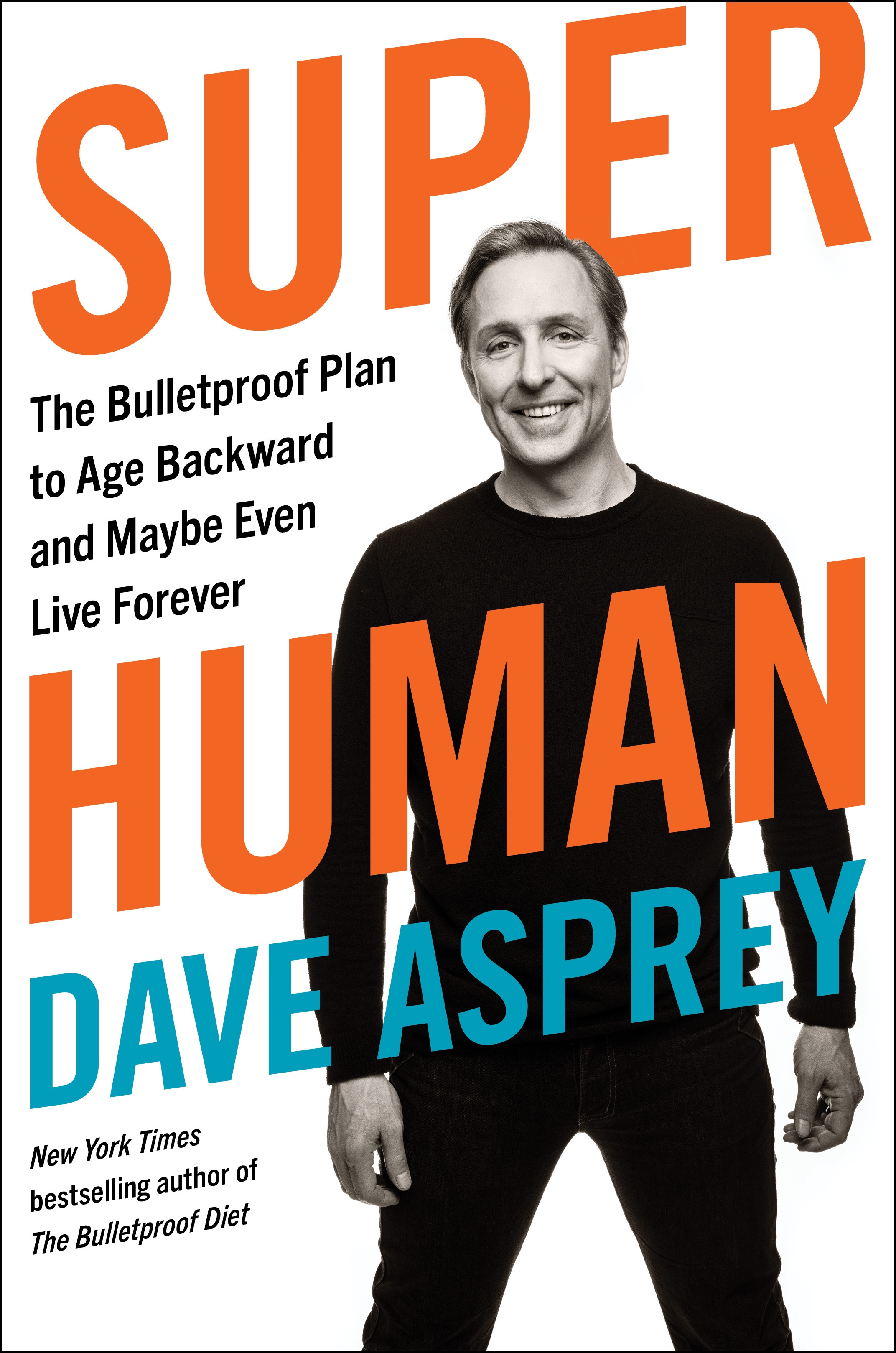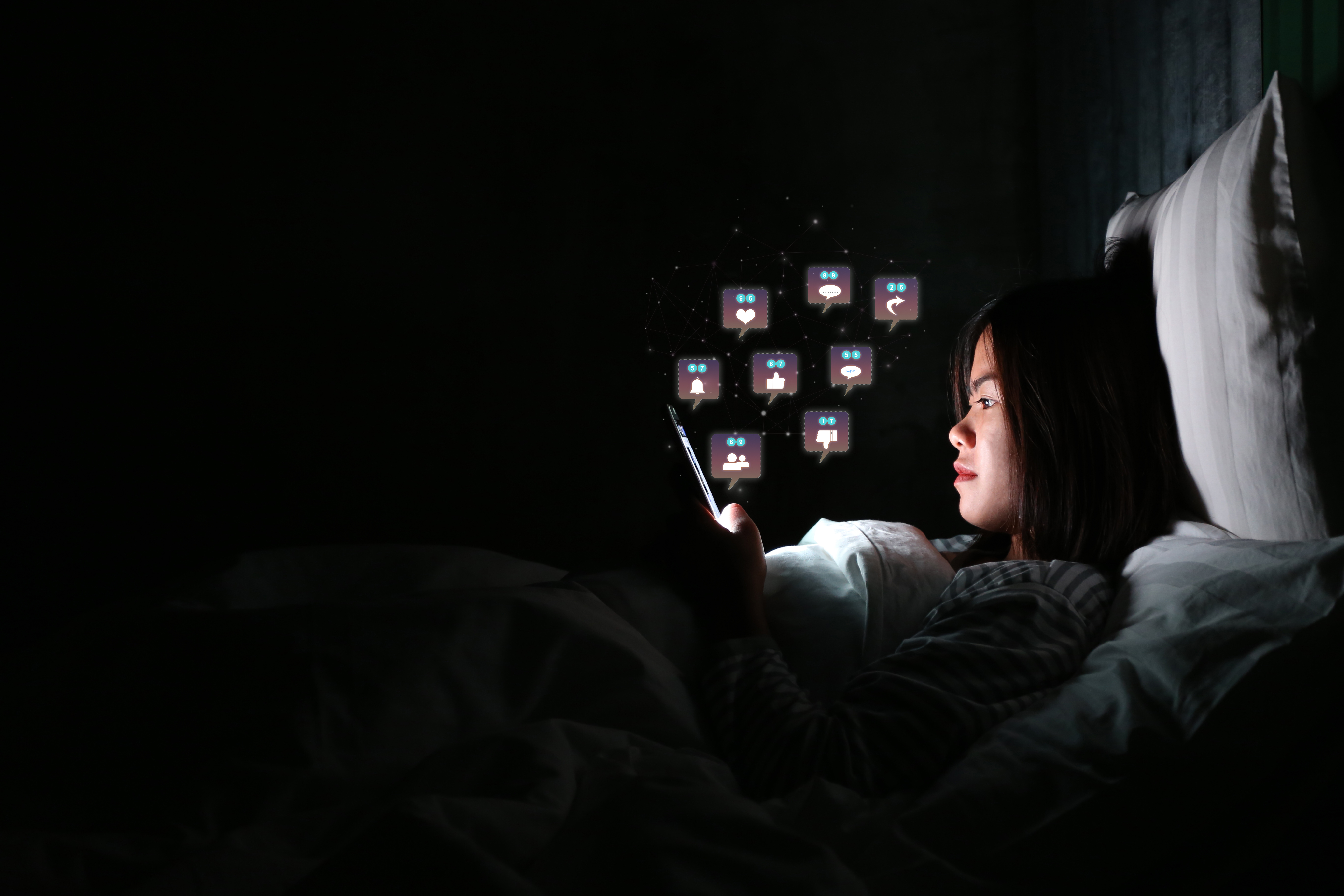Clock neurons control our circadian rhythm. There are approximately twenty thousand of these neurons in the base of our brains that act as our bodies’ master clock. As our eyes encounter various forms of light throughout the day, they send information to these neurons. About a quarter of these clock neurons can sense onlyblue light. When the eye is exposed to blue light, whether it’s from the sun or your iPhone, these neurons send a signal to the rest of the master clock neurons and, collectively, they report to the brain that it is time to wake up and remain alert. Like most animals, we are designed to synchronize our internal clocks with blue light because sunlight is actually the richest source of blue light that exists. We are meant to be highly sensitive to even small amounts of blue light so we can begin the waking process as the sun is just starting to rise in the morning.
But the world we have created is full of light, including artificial sources of blue light that are emitted not just in the morning, but also well after the sun goes down. This is a recent change to our environment. A hundred years ago there was simply no way any human could encounter a light brighter than fire after the sun had set. Now, no matter where we live, we are bombarded with blue light well after dark. As a result, we have disrupted not only our natural sleep cycle, but also the rhythms that keep our bodies functioning optimally.
This disruption has many invisible (and some visible) consequences that influence how we age. There are two steps to halting this disruption. Step one is reducing blue light exposure (so you don’t die). And step two is adding beneficial light sources to help you gain Super Human powers . . . just like Superman.
Reduce Junk Light to Live Longer
Excess blue light exposure increases your risk of the Four Killers. One reason artificial blue light is such a problem is because it suppresses your body’s production of melatonin, a hormone that tells you when it’s time to go to sleep. Low production of melatonin is associated with poor sleep and increases your risk of cancer.
Excess blue light also causes inflammation and mitochondrial dysfunction, primarily because of its impact on glucose control. In the evening, exposure to blue light causes a peak in glucose levels, leading to higher blood sugar and an increase in insulin resistance.2 This means your blood sugar is higher than it should be, and your body doesn’t adequately move that sugar out of your bloodstream. The result is that you are at a greater risk of weight gain3 and developing type 2 diabetes—which, as you already know, increases your risk of the other three killers.
Yet blue light is not just in your electronic devices. Sadly and problematically, it is everywhere. Most modern light sources contain unhealthy amounts of blue light and far too little of the beneficial spectrums that help balance it out. This is what I call junk light. For example, white LED bulbs lack many of the sun’s natural frequencies that our bodies and brains need to function, such as infrared, red, and violet light. They also emit at least five times more blue light than is emitted by sunlight. Fluorescent lights also emit substantially more blue light and less infrared light than sunlight. Shining these junk light sources into your eyes close to bedtime is like Superman taking a little soak in a kryptonite salt bath to prepare for sleep.
In addition to wrecking your sleep and your blood sugar, being exposed to all that blue light, especially at night, taxes your mitochondria by creating excess free radicals in the cells of your eyes. When you are exposed to full-spectrum light, your mitochondria still produce some free radicals, but those free radicals send a signal for the cell to produce extra antioxidants to sop them up. When you are exposed to blue light without the full spectrum of frequencies, the free radicals your mitochondria produce fail to send that signal. Those excess free radicals linger, damaging cells and contributing to all Seven Pillars of Aging.4
Exposing yourself to junk light instead of sunlight or incandescent light, which contains less blue light than other artificial sources, is kind of like the difference between eating a normal meal and eating a bowl of sugar containing the same number of calories. Blue light is the high-fructose corn syrup of lighting. And when you consider the fact that the average American spends 93 percent of his or her life under artificial lights, most often fluorescent or LED, it’s no surprise that the incidence of all Four Killers is on the rise.
At the same time that we’ve removed beneficial light frequencies from much of our light sources and replaced them with far too much blue light, we’ve also begun to completely avoid ultraviolet A (UVA) and ultraviolet B (UVB) light, which are produced by the sun and are necessary for survival. While too much UVA and UVB is damaging, so is too little. When your skin is exposed to UVB light, your body converts vitamin D to its activated, sulfated form. In other words, sunlight makes vitamin D more available so your body can use it.
As we’ve discussed, having enough vitamin D is essential for longevity. Too little vitamin D plays a role in the buildup of amyloid proteins, one of the Seven Pillars of Aging. Vitamin D is also critical for setting your circadian rhythm and for the regulation of blood sugar. This is one reason why blood sugar levels are naturally lower during the summer months, when you are exposed to more sunlight.5
Recent research also has found a direct correlation between a lack of adequate sunlight exposure and the onset of diabetes. One study that tracked a thousand women between the ages of twenty-five and sixty-four for eleven years concluded that the women who had “active sun exposure habits,” meaning they were regularly exposed to sunlight, had a 30 percent lower risk of developing diabetes than the women who got very little sun exposure.6
By avoiding ultraviolet light completely, we are inadvertently speeding up the aging process. And it’s important to note that while I do recommend supplementing with vitamin D, this does not fully replicate the effects of natural sunlight on blood sugar control.7 Nothing can fully replace the full spectrum of light that we are meant to get from the sun.
In fact, there’s a lot of interesting research around the benefits of being exposed to the sun’s red and near infrared frequencies before you are exposed to UV light. The red and infrared light seems to prepare the cells so they can harness the power of UV rays to produce vitamin D, while naturally protecting themselves from any UV light damage. It also helps the cells recover after UV light exposure.8 This chronology of light exposure makes a lot of sense, as it corresponds to our circadian rhythm.
Early humans were up at dawn and spent time outdoors in the morning, which allowed them to be exposed to the red and infrared light of sunrise before the sun peaked at midday. Now we spend far more time indoors under unnatural lights. If we do get natural sun exposure, it’s often in the middle of the day, when the sun is at its most intense. Our cells don’t have a chance to prepare for that UV exposure without the help of red or infrared light. Is this why incidents of skin cancer have increased despite our frequent and often obsessive use of sunscreen? I wouldn’t be surprised if lack of exposure to these frequencies plays a role in the severity of the sun damage we experience now.
It’s ironic that we avoid the sun to protect our health, while in reality adequate but not excessive sun exposure helps us live longer. A recent study of twenty-nine thousand women in Sweden who were tracked over twenty years concluded that “avoidance of sun exposure is a risk factor for death of a similar magnitude as smoking.” The study showed that people who avoided the sun had a reduced life expectancy of between 0.6 and 2.1 years.9
This may sound surprising, but the circadian rhythm, which is controlled by light, is fundamental to all life’s survival on this planet. Animals, humans, plants, and even fungi all go to sleep and wake up in twenty-four-hour rhythms. This is so ingrained that if we took an animal or plant from our planet and put it on Mars (or any other planet that has a day/night cycle that’s not twenty-four hours), it would struggle to adapt and might not survive. That is profound.
Dr. Satchin Panda from the Salk Institute has studied the impact of the disruption of circadian rhythm on health and longevity. He says that when animals in a laboratory have a mutation in their circadian clock, their risk factors increase for a number of killers, including diabetes, obesity, cardiovascular disease, and cancer. In fact, when humans’ circadian rhythms are altered in a lab (study participants are restricted to five hours of sleep), they begin to exhibit symptoms of these killers within only a few weeks.
Listen, I’m not suggesting that you stop using electricity or move out to the middle of the woods somewhere or live naked in the sun. There are ways to enjoy the conveniences of modern technology without harming ourselves in the process. In fact, you can use natural and beneficial sources of light to nurture your circadian rhythm and prevent and even reverse much of the aging and disease that junk light can cause.
One simple way to do this is to install red lights, which include more of the sun’s natural frequencies. Red light is at one end of the visible light spectrum, the electromagnetic spectrum of light that’s visible to the human eye. Meanwhile, infrared light has a wavelength that’s just beyond the red end of the spectrum. You can’t see infrared light, but you can feel it as heat. It is the reason why exposure to direct sunlight makes you feel warm.
At my house on Vancouver Island, all the exterior lights are red. My friends may tease me for giving the appearance of living in a submarine or some kind of house of ill repute, but I’m able to go outside at night without disrupting my circadian rhythm. Plus, I can see the stars. In addition to benefiting my health (and the health of my family), red outdoor lights are also healthier for the animals living near my home. Unlike white LED porch lights, my red lights don’t attract bugs. This matters more than you might think, especially since most people who attract bugs with junk light go on to kill them with pesticides. According to researchers, 40 percent of the world’s insect populations are in decline and could die out in the coming decades. You know, the years you’re planning to live through. The lead author of this paper from the University of Sydney in Australia says, “If we don’t stop it, entire ecosystems will collapse due to starvation.”10
The other reason I use exterior red lights is that it seems irresponsible to knowingly mess with the circadian rhythms of animals around my home. I have three different species of owls that nest within a hundred yards of the house because our red lighting doesn’t ruin their habitat. It wasn’t until I saw this that I realized how much junk light affects every living thing on the planet. So get some red LED bulbs for your landscaping, and get ready to field questions from your neighbors. They’ll either think you’re cool or proposition you. Either way, you’ll live longer.
Another way to use light to your advantage is to install light sources inside that give off the full range of frequencies. At the Bulletproof Coffee shops we have a big light box around the door that changes color based on what time of day it is to help promote a healthy circadian rhythm. And at our new Bulletproof headquarters we have low voltage halogen lighting on dimmers and backup LED lighting so we can add red and amber frequencies in the evening to mirror the natural rhythm of the sun.
One of the easiest ways to make the light in any environment healthier is simply to install dimmers that allow you to dim the main light source and change its richness. If you have an opportunity to switch out the lights in your home or office environment, I strongly encourage you to take color spectrum into account. Don’t make yourself crazy about getting it perfect all the time—stress like that makes you old. Just aim to get it mostly right at home, and you’ll be so far ahead of the curve that you’ll feel it.
When it comes to blue light, we’ve already discussed how to reduce your exposure from electronic devices in chapter 4. Here are some additional ways to eliminate aging light sources from your environment:
- Starting at 8:00 p.m., dim all the lights in your home. Switch to lighting your environment with red LEDs (or candles if you want extra credit).
- If you can’t install dimmers and/or have to be in a brightly lit environment after sundown, wear glasses that filter out blue light. If you’ve seen me onstage, you’ve undoubtedly noticed the yellow-tinted glasses I wear indoors to filter out some (but not all) blue light. I probably would have gotten picked on in high school for this, but now I am convinced that they look cool.
- If you don’t want to use glasses that filter out blue light but have to be in a brightly lit environment after dark, wear sunglasses if appropriate.
- Go outside for ten to twenty minutes a day to get adequate (but not too much) UV light exposure. Try to do this in the morning before the sun is at its peak, and you won’t need sunscreen.

From the book SUPER HUMAN by Dave Asprey. Copyright © 2019 by Dave Asprey. Published on October 8, 2019 by Harper Wave, an imprint of HarperCollins Publishers. Reprinted by permission.
Follow us here and subscribe here for all the latest news on how you can keep Thriving.
Stay up to date or catch-up on all our podcasts with Arianna Huffington here.


